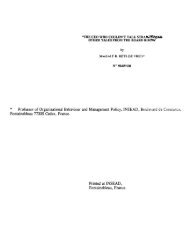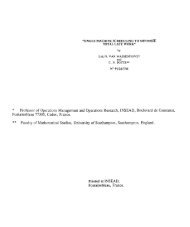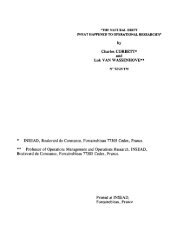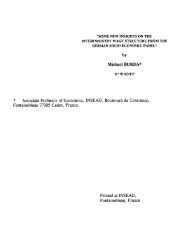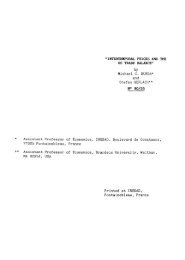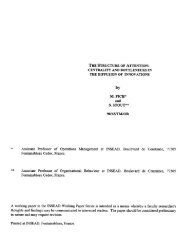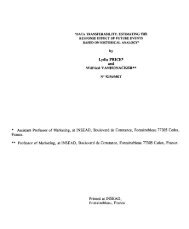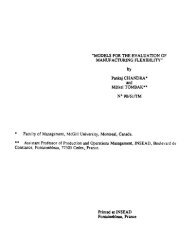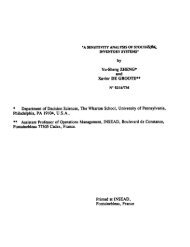* Assistant Professor of Operations Management at INSEAD ...
* Assistant Professor of Operations Management at INSEAD ...
* Assistant Professor of Operations Management at INSEAD ...
Create successful ePaper yourself
Turn your PDF publications into a flip-book with our unique Google optimized e-Paper software.
problem<strong>at</strong>ic in the situ<strong>at</strong>ion described by the present model. Only additional<br />
inform<strong>at</strong>ion about customers will help the firms to restore the equilibrium.<br />
In contrast, the Mendelson and Whang model autom<strong>at</strong>ically enjoys incentive<br />
comp<strong>at</strong>ibility when service r<strong>at</strong>es are equal, because demand rel<strong>at</strong>ionships<br />
and differing price sensitivities are absent. Thus, the most favorable situ<strong>at</strong>ion<br />
in their model becomes the most problem<strong>at</strong>ic case in this model.<br />
I conclude this section with an example th<strong>at</strong> demonstr<strong>at</strong>es the implement<strong>at</strong>ion<br />
<strong>of</strong> the equilibrium via the proposed contract. The example has the<br />
standard two firms and three market segments. The three order types are<br />
characterized by service r<strong>at</strong>es <strong>of</strong> (p i , /1 2 , p3) = (6, 3,5). The waiting cost<br />
r<strong>at</strong>es are (c1 , e2 , c3) = (2,3,1.5). Then the waiting-cost-to-service-time r<strong>at</strong>ios<br />
are (12,9, 7.5) for the three groups, which means th<strong>at</strong> type 1 orders<br />
receive highest and type 3 orders receive lowest service priority. The specific<strong>at</strong>ion<br />
<strong>of</strong> the example is completed by the three demand curves, which are<br />
(Pi (x), P2 (y), P3(z)) = (2 — 2x,10 — 10y, 2 — 2z). We observe th<strong>at</strong> all three<br />
segments are <strong>of</strong> the same size, and the second segment is more price-sensitive<br />
than the other two.<br />
Each firm produces an output <strong>of</strong> (A l , A2, A3 ) = (0.246, 0.285,0.255) in<br />
equilibrium. The corresponding average throughput times are (W1 , W2 , W3) =<br />
(0.217, 0.392,0.269), and the market-determined cash prices are (p i , p2, p3)<br />
(0.583,3.123, 0.577). It may be surprising th<strong>at</strong> type 2's throughput time is<br />
longer than type 3's, although type 2 has higher priority. This is caused by<br />
the type 2 service time * being almost twice as long as *, which more than<br />
makes up for the shorter time spent waiting in the queue.<br />
Figure 2 demonstr<strong>at</strong>es th<strong>at</strong> the equilibrium prices do not fulfill the incentive<br />
comp<strong>at</strong>ibility condition. The first table in the figure shows th<strong>at</strong> both<br />
type 2 and type 3 customers have an incentive to lie and sign up as type 1,<br />
because th<strong>at</strong> will lower their expected full prices.<br />
The second table in Figure 2 presents the d<strong>at</strong>a <strong>of</strong> the contract according<br />
to Proposition 2. The third table specifies the expected full prices for<br />
the different signup-options <strong>of</strong> the customers under the incentive-comp<strong>at</strong>ible<br />
pricing contract. We see th<strong>at</strong> it is in the best interest <strong>of</strong> all customers to sign<br />
up under their true types. The customers truthfully separ<strong>at</strong>e themselves,<br />
and moreover, if they tell the truth, then they face expected full prices equal<br />
to the full prices in the equilibrium in the first table.' Thus the proposed<br />
6The slight differences between the diagonal elements in the first and the third table<br />
are due to rounding errors.<br />
15



